
Last Tuesday, on a day when the Scottish Fire and Rescue Service had issued very high fire risk warnings for the whole of Scotland, I drove up to Braemar to spend a couple of days in the Cairngorms. The muirburn I had commented on in a post previously (see here) was continuing on both sides of Glen Shee and over the pass into Glen Clunie beyond on the way to Braemar.
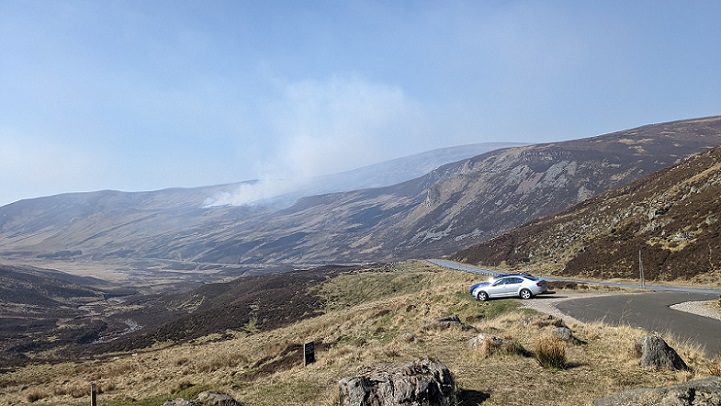
On the way up to the Devil’s Elbow, Rhiedorrach Estates had been carrying out muirburn right next to the A83:
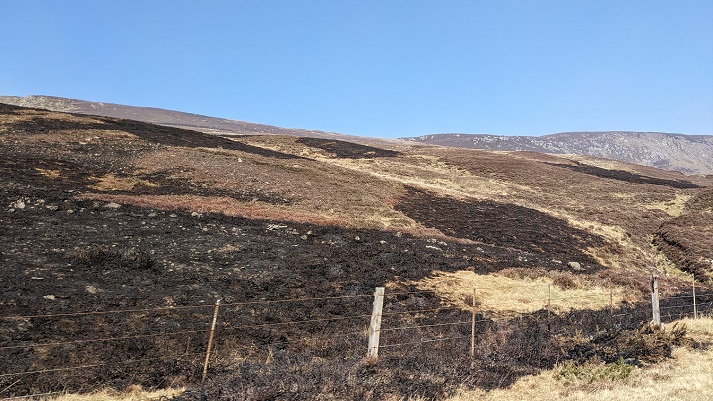
Such muirburn is contrary to both the current Muirburn Code and the proposed new version being consulted on by NatureScot, both of which state “You MUST NOT Burn within 30m of a public road”.
Judging by the way the muirburn has crossed over the fence it appeared the fire got out of control, hardly surprising given the very dry and windy conditions over the previous two weeks.
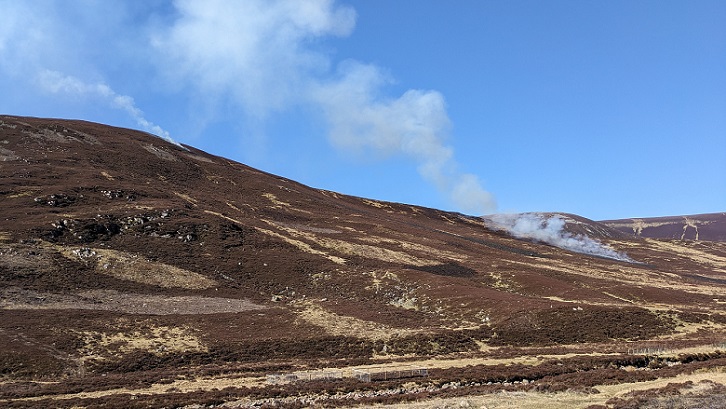
From the Glen Shee ski centre northwards the land on both sides of the A83 is owned by Invercauld Estate. There were two fires on Strone Baddoch, on the west side of the road. Under the Moorland Code a minimum of three people are supposed to form burning teams. I did spot three through my binoculars, two by the upper fire which appeared to have raced up the hillside before being brought under control, and one by the lower which appeared to be burning across a broad front:
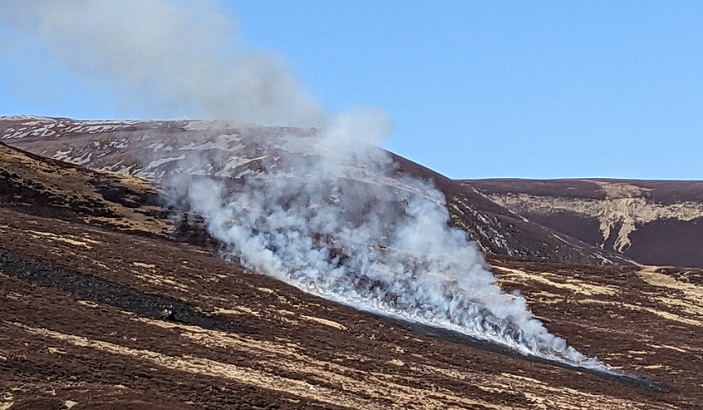
There was no way the two people working to direct the upper fire could help the person by the lower fire to do so and no sign of heather mowing which is now often used to help keep muirburn within fixed boundaries.
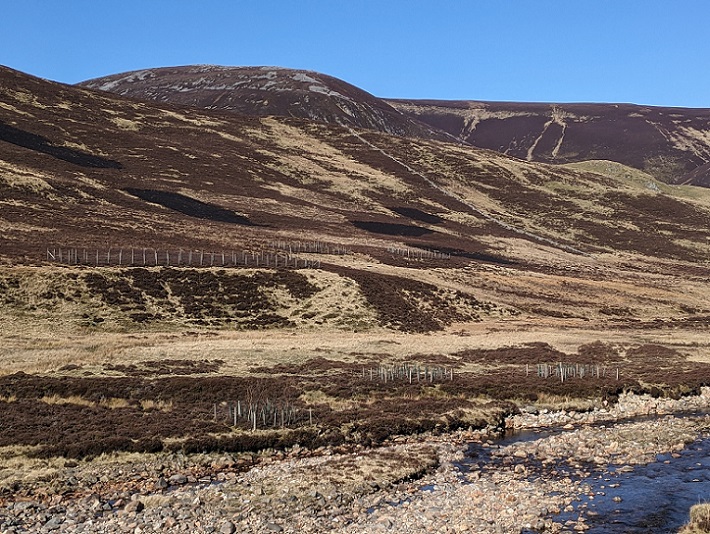
Two days later I drove back past Strone Baddoch. The muirburn on the lower, less steep ground had been contained and had resulted in patches. That on the steeper ground had run up to the skyline and created strips denuded of vegetation (which will facilitate more rapid water run-off raising flood levels below) :
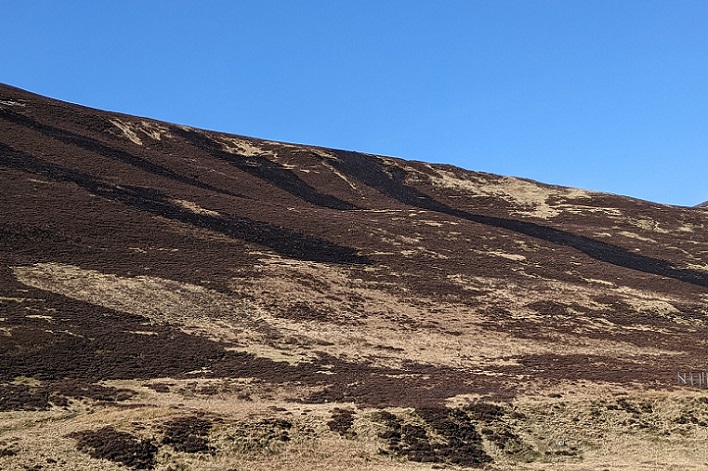
There is a good explanation for the difference between what is shown in the two photos in the current (voluntary) Muirburn Code which, as a consequence, advises against muirburn on slopes over 27°:

The revised Muirburn Code, out for consultation by NatureScot (see here), has removed all reference to the dangers of burning on steep slopes and changed what will become a statutory requirement to:
- Do not burn on slopes steeper than 1 in 1 (>45 degrees).
- Only burn on a slope greater than 1 in 2 (>27 degrees) if you are experienced and use appropriate technique
No justification has been provided for these proposed changes and the best explanation for them is that NatureScot, like the CNPA (see here) , the Scottish Fires and Rescue Service (see here) and Scottish Government are all basically under the thumb of Scotland’s sporting estates. All should basically take a look at the evidence on the ground.
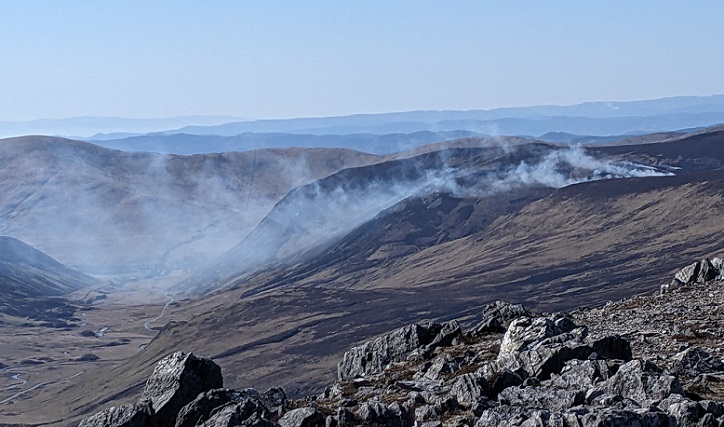
On the way home I took my niece, who was with us, up the Cairnwell chairlift for a bit of very easy hillwalking (and to support a company whose enterprise contrasts with HIE at Cairngorm Mountain). It was very windy on top as per the weather forecast – I estimated the winds were 40pmh – but to the south Rhiedorrach was still being burned and the smoke was being blown across across Glen Shee and the A83 (its completely foolhardy that NatureScot is proposing to remove any reference to a maximum wind speed for muirburn from the new Muirburn Code (see here)).
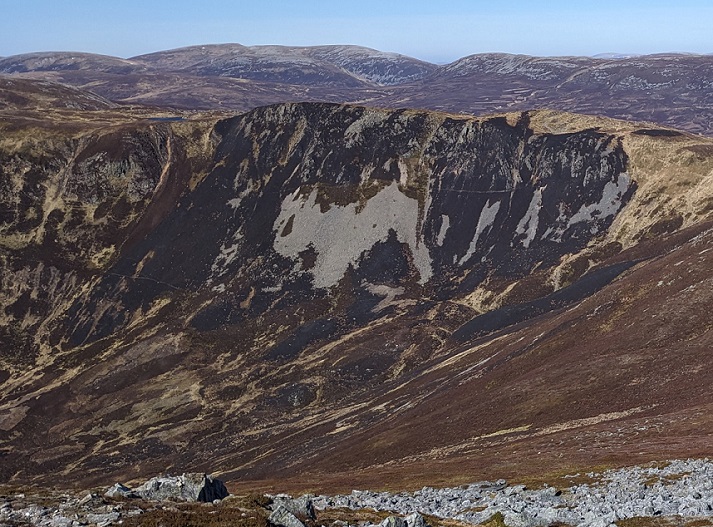
Looking west from just below the summit we spotted this shocking example of what can happen when muirburn gets out of control and is conducted on steep slopes. The muirburn has triggered a wildfire that has run up and across the crags and even appears to have jumped over the boundary with Invercauld at the top.
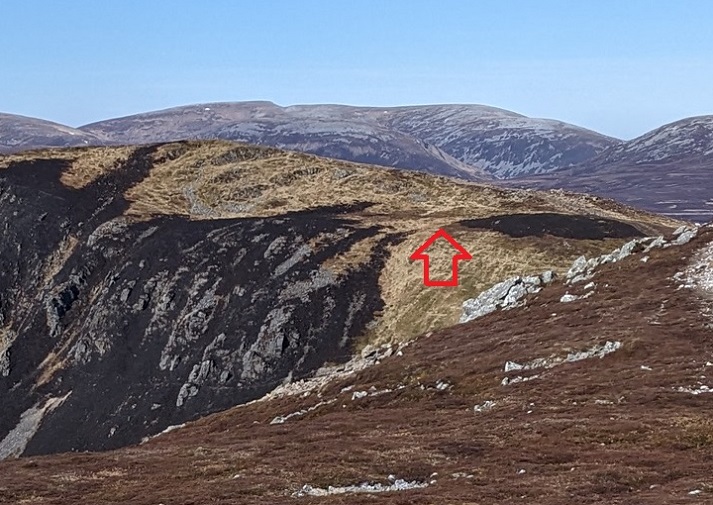
Having walked this ridge several times in summer I know it once provided one of the best places to see breeding golden plover and ptarmigan in Scotland. Now part of their feeding ground has been destroyed, along with the refuge which the crags provided for plants from grazing deer.
Even NatureScot’s proposed new version of the Muirburn Code states:
“Do not burn where vegetation is kept short by high winds (wind clipped) and where burning risks removing vegetation cover, leading to erosion. This includes summits (the highest point of a hill or mountain) or ridges.”
Burning like this should at the very least be a criminal offence but unfortunately at present there appears to be no monitoring by public authorities of extremely damaging wildfires like this and I doubt it has even been registered with the SFRS and CNPA (I will check).
The last financial statements for Rhiedorrach Estates LLP (for the year until 31st March 2024) state it employed no staff so it may be that contractors caused this destruction. Responsibility, however, lies with the two people who own Rhiedorrach Estates LLP, whose registered address is in Staffordshire: Mrs Heather Johnston and Mr Wayne Douglas Johnston. In my view they are not fit to own this land. Unfortunately, the latest Land Reform Bill being considered by the Scottish Parliament offers no solutions to the ongoing destruction of the land in Scotland by sporting interests.
Worse, the Scottish Government is actually paying significant sums of money to Mr and Mrs Johnston, including for “forest area viability” and “greening purposes”:

The current Muirburn Code states under Section 2.5. Public Funding and Payments – Conditions:
“Under cross compliance, recipients of direct support payments (e.g. Basic Payment Scheme) have to meet certain requirements known as Good Agricultural and Environment Conditions (GAECs), some of which relate to the Muirburn Code. Failure to meet these requirements can result in a reduction being applied to support payments”
Anyone who has read my last few posts on muirburn and the Muirburn Code will not be surprised to learn that NatureScot has removed all references to cross-compliance from its proposed new version of the code. One wonders whether there has been a single example in Scotland of the Scottish Government reducing support payments to sporting landowners because of their failure to meet the requirements of the current Muirburn Code?
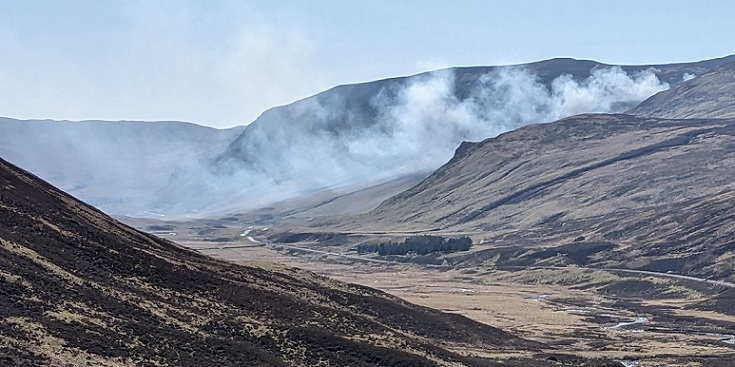
A couple of hours later after a walk over Carn Aosda – where we saw a golden plover – and a coffee in the Glen Shee Cafe we drove back down Glen Shee. The burning on Rhiedarroch was continuing and the smoke still billowing across the road. Those directly responsible appear to care little for their own health, that of fellow humans or the waders returning to breed let alone the wider environment but probably have no choice. Do birds like humans get lung cancer from smoke? What is Transport Scotland doing to stop this disgrace?
While I would encourage anyone concerned about wildfire to respond to NatureScot’s consultation on the Muirburn Code (see here) urging them to strengthen it rather than weaken it as they propose, muirburn licensing was never going to address the real problem. We need to ban muirburn completely (creating fire breaks to limit wildfires is a completely different issue and does not need to start with fire). Sporting estates, which exist to provide private pleasure to those who enjoy killing other creatures rather than value nature, will never voluntarily act in the public interest or abide by any code if its not in their interests to do so.
The Scottish Government should start to use its powers to compulsorily purchase sporting estates which have proved themselves incapable of managing the land responsibly. A good place to start would be all those estates that have carried on with muirburn in National Parks and other protected areas despite the warnings of high risk from the SFRS. What’s been happening at Rhiedarroch should provide the Scottish Government and the CNPA with all the evidence they need to act.
Postscript
After writing this post my attention was drawn by Raptor Persecution UK to this excellent article by Tom Bowser in the National (see here). All Tom Bowser’s arguments are equally applicable to the way NatureScot is approaching muirburn licensing.

The ‘accidental’ burn through the steep ground and crags of Choire Dhirich will ‘unfortunately’ probably have disrupted any breeding attempts by crag-nesting raptors or ravens. Such a shame for the estate!
I was in Glen Callater (Invercauld) recently and saw muirburn being carried out there that doesn’t comply with guidelines – the 2 live burns at the time had one person each. One of the burns started and the chap left to start another leaving the first unattended. One of them was on steep ground. The other was directly beside a waterway. Pretty sure some of the many recent areas burned there are on peat.
The last I knew King Charles leases the shooting rights in Glen Callater – perhaps the factor at Balmoral could confirm whether that is still the case or not?
There has been a huge amount of muirburn going on in Strathspey during all the recent dry weather, plenty of windy days here for it to get out of control. Echoing Nick’s comments about tree planting for estates – Glen Banchor estate behind Newtonmore has been paid large sums of public money to fence a small strip of land either side of the River Calder and plant with trees to enhance the river environment. Yet a few hundred yards north of the river whole hillsides have been extensively burnt right up the side glens and onto ridges and hill tops. It is a farce to claim it for conservation purposes. It is even more farcical as the estate has not had driven grouse shooting for the last few years due to low numbers of grouse, yet they still burn burn burn.
There are once again too many inaccuracies in this article to correct them all. Rotational heather burning has significant benefits for all moorland bird species and how ridiculous to even think to suggest that birds might get sick from heather burning, what anthropomorphic rubbish!
The heather clad high moorland areas of Ireland, England and Scotland are a globally unique environment with over 75% of the world’s heather rich environment in the UK. This unique environment is maintained and managed in considerable part by using hill grazing and heather management ie rotational heather burning and cutting. Sadly this unique global environment is under threat from non native afforestation, some farming practices (overgrazing heather margins and liming), and the obsessive calls to regulate, ban, bar etc
(Please note Nick that cutting is only possible on flat and rock free areas (try finding much of that in the Grampians!))
The sale of fishing, shooting, including grouse shooting and deer stalking bring huge financial benefits to the remote areas covered in the article – helping keep hotels and local businesses in business, people in jobs and communities functioning. I appreciate that some of these visitors are very wealthy (which you may not like) but they spend huge amounts of money in a way that cycle events for instance do not.
Heather burning benefits all moorland birds and helps prevent large scale wildfires like the one in Galloway. One of your readers points out that there seems to be little muirburn in Galloway – well let me explain why. The massive programme of largely Scottish Government funded afforestation, huge largely non-native sitka forests in the 50’s, 60’s and 70’s and still ongoing, led to a collapse in ‘keepering’ and moorland management in the south west of Scotland. Landowners simply gave up and predators gobbled up most moorland birds – try finding a curlew, black grouse, ptarmigan or plover, they simply DO NOT exist there anymore. The large wildfire in Galloway is precisely because no rotational, strip burning is taking place…. there is nothing to stop the fires which then become huge scale and rampage into bog and other wetland precious environments, many of which were drained and harmed by this very planting and are now smaller in size .
It is the very practice of muirburn and heather cutting which sustains and protects the unique moorland environment of the Cairngorms and Grampians.
A few other points:
Many of the fires in your recent photos bar one are examples of great burning and are not on slopes too steep to burn. However I agree that the photo of the crags opposite the Cairnwell show very poor practice indeed. However I drove up the A93 the other day and almost all fires were strips and in line with good practice.
Greening payments are farm payments relating to livestock management on grassy areas, ie the maintenance of viable grassland (they are not for what I think you mean by ‘greening purposes’, although they do benefit the environment, as does the rotational heather burning carried out by the owners of Rhiedorrach.
The vast majority of privately owned moorland estates burn with great care and consideration. It is notable that the recent spate of wildfires was not caused by them, more generally by glass bottle litter, bbq’/s etc. And when these events occur it is the privately funded estates who come to the rescue. A recent out of control fire lit by a commercial sheep farmer was put out by 40 people plus kit from private estates (none of whom was out rotational heather burning because they knew it was too dangerous). SFRS attended the blaze but said they could not have controlled the fire without these private assets and local volunteers all from estates.
If heather burning was banned, there would be no infrastructure to deal with wildfires (bar limited SFRS assets), little or no moorland wildlife, and no income to support local rural communities, no jobs, no children, no schools, nothing — you need to be very careful what you wish for.
If we had a far more modern land ownership and land use arrangement in Scotland, there wouldn’t be this incessant and often paltry excuse-making by land owning interests.
Heather burning needs to be better managed and reduced over time I think that is clear. I have seen Caledonian pinewoods torched by an out of control muirburn by a sporting estate in the CNP just a few years ago. The pinewood was protected habitat, but the absentee estate owner was let off without even a slap on the wrist! The very notion that stronger controls on muir burning will lead to the closure of rural Schools and mass unemployment is a risible statement and demonstrates that you either have a poor understanding of the rural economy or you are simply a blatant propogandist. If I am wrong please list the objective studies that support your claims.
Dougie, the Muirburn licensing bill will hopefully provide the teeth to slap the wrists of repeat offenders, or those who burn recklessly. This only comes into effect next year and we will know in 5 years or so how this is working. Accidents can happen but repeat offenders who ignore the tenets of the law will lose their licence, rightly so.
On your 2nd point the article was suggesting an outright ban not stronger controls. With an outright ban Estates would have to lay off keepers, rangers but the impact would extend to shops, hotels and these in rural areas are often pretty marginal businesses. Of course there are no studies because no one has done it yet and it would be hard to model. There are studies that show that grouse shooting contributes about £100m-£200m per annum to the rural economy – all forms of shooting much much more. In Glen Prosen I believe the laying off of all the keepers/stalkers, and turning their houses into holiday houses has had a significant impact on the community and local school etc. I hope someone is studying it.
Just to respond to your first para, which is full of unsubstantiated assertions, there has not been much research on the impact of smoke on birds but there is evidence that smoke affects their health so the question I asked is NOT anthropomorphic rubbish as you claim. Yes there are important differences in the physiology of birds and mammals and humans other mammals but knowing what we do about the harmful impact of smoke on humans – those with responsibility for public health should be concerned about lung cancer rates among gamekeepers – the question really is why wouldn’t smoke impact on the health of other animals?
This really is becoming crazy now. As rotational burning aims to cover about 1/50th of a moor per annum and most birds, and moorland creatures live for no more than a few years and the typical fire burns for about an hour, the chance of any bird or animal having any exposure let alone impact in its entire life is close to nil. Occasionally I have been burning and seen a bird or deer and they always run off/ fly off – not surprisingly they move a bit faster than a fire, and guess what they are frightened of humans so are gone before a match its struck.
Even if everything you have written was utterly wrong (none of which is wrong), this muirburn issue flies in the face of UK and ScotGov ‘Net Zero’ targets. It’s no good every home owner paying 8% Green levy on our energy bills if rampant fires across vast swathes of ground are going to be burnt with the consequent release of CO2 and the deeper damage to ancient, glacial soils purely for the selfish, anachronistic industrialisation of moorland for money-making!
Hi Andy
You are right that homeowners should be concerned when paying so much on their energy bills whilst watching jobs disappear in Aberdeen and elsewhere every day as the North Sea gas business is crushed and as we continue to export jobs to China where their factory’s use power with much worse carbon credentials than ours. I can only direct you to a book by Ian Coghill, a down to earth councillor at Birmingham City Council called Moorland Matters. Read Chapter 2 ‘a burning issue’ and then more than happy to discuss your points above. ‘Cool Burn’ the technique we use for rotational heather burning releases CO2 but in minimal amounts, and fractional when compared with wildfire. Cool burn does not touch the glacial soils but wildfire does. One wildfire in Sutherland in 2019, in an area where the RSPB had stopped rotational burning, burnt for weeks and released 290,000 tonnes of CO2 equivalent to 3% of all Scotlands CO2 emissions.
There are lots of things you could describe as a globally unique environment, some good some bad. However, the grazing and rotational burning of heather are for the benefit of grouse shooting. The idea that this is done for some wider public benefit doesn’t bear scrutiny. It wouldn’t be happening but for grouse shooting. Any other supposed benefits are purely coincidental.
I have seen plenty of muirburn that had got out of control. As for the Galloway fire I was in the area when it started. The wind speeds were exceptional on the Friday morning. I watched what was happening from the Corserine ridge and what happened bears out the points made in the blog. It’s most serious impacts were on the steep ground on the crag aprons and crag surrounds themselves above Silver Flowe in particular. Much bigger in extent but reflected by the picture in the blog.
Hi Andy – as I have replied elsewhere the Galloway fire was likely worse because rotational burning has been abandoned in the area. To be clear that fire was not related to rotational burning for grouse shooting. I appreciate that others like the one up the A93 Cairnwell are an example of very poor burning. I don’t deny that many of the benefits of rotational heather burning are coincidental but the people doing it can see those other benefits. Many of them are passionate conservationists, the King included. It’s the moor owners who have long fought the battles against industrial scale sitka spruce planting, and the draining of bogs. See book Moorland Matters – Ian Coghill.
Hello Colin. I know Galloway Forest Park isn’t a grouse shooting area. I know plenty of muirburn that has got out of control. One of the worst being the entire eastern flank of the Cromdale Hills. I used to live on Abergeldie next door to Balmoral and never saw much by way of conservation there just plenty of traditional mgt for grouse and red deer.